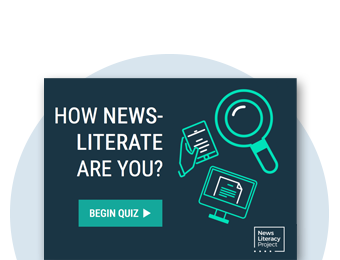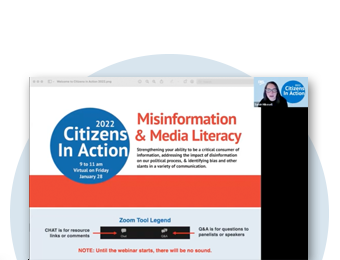Know Your News
Spot Misinformation and Minimize Overload
Today, information is being sent and received at the speed of light. Consuming news, in particular, has become increasingly overwhelming and tricky. Often times, people are unsure if the information they’re getting is 100% accurate or get overwhelmed with the amount of information they are exposed to. This guide to knowing your news will provide tips on spotting and combating misinformation, as well as minimizing information overload.
Avoid False Information
Many individuals are concerned about allegations of “fake news,” which can be described as the intentional or unintentional spread of misinformation through various forms of communication (news outlets, television, radio, social media, etc.). Social media is designed to spread information more rapidly than traditional media. This characteristic can often be helpful, but also means the misinformation and disinformation can spread quickly via shared articles, tweets, posts, and images. Misinformation is any false information, regardless of whether it is intentionally created and spread. Disinformation is any false information that has been created or distributed with the intent of misleading or deceiving others. It is important to know the difference, as both can be harmful to your news consumption.
Build Your Media Literacy
The National Association for Media Literacy Education (NAMLE) defines media literacy as “the ability to access, analyze, evaluate, create, and act using all forms of communication.” Part of being civically engaged means that we must determine the validity of the information we consume and share – in other words, recognizing misinformation and disinformation. Although it may be hard to spot at times, the tips and tricks below should make identifying misinformation a lot easier.
Shouldn’t News Be Biased Toward the Truth?
In addition to other good news consumption practices, the News Literacy Project cautions against false balance. In other words, news should be biased toward the truth. Media should not cover one perspective or “side” of an issue in an attempt to remain objective if that perspective is based on false information. Articles regarding scientifically-proven facts or well-documented events should purposely be biased toward reporting those facts, not false information or baseless arguments. For example, the Apollo 11 moon landing in 1969 was a well-documented historical event. Media reporting today on the history of space travel or moon landings do not need to entertain conspiracy theories that the Apollo 11 moon landing was faked.
How to Identify and Fight Against Misinformation and Disinformation
In order to decipher whether information is real or false, follow these steps:
Consider the Source
When reading an article online:
If it’s from a trustworthy, reputable, or major news source, it is more likely that the information is true.
Be wary of information on social media that has no listed sources to back up the claims. “Breaking” or shocking news may contain misinformation if not corroborated by other major news sources.
Clickbait will often have eye catching images and outrageous headers. If it seems too outlandish and isn’t from a major news outlet, it may be misinformation or over-simplified. Even major news outlets can sometimes dramatize or sensationalize headlines, so it’s important to read the full article and not just skim headlines.
When in doubt, newspapers, libraries, and nonpartisan organizations that study policy, like universities and some think tanks, can be great resources for double-checking information.
When reading an article in a newspaper:
Make sure that the article is an objective report. Opinion pieces like commentaries, letters to the editor, and editorials are typically written with a subjective perspective and based on the discretion of the writer. These are still good to read, but should not be mistaken for objective reports from journalists.
When watching TV:
Commentary shows on television are fine to watch, but may require additional research on your own. Commentary shows are also opinion pieces with a subjective perspective and based on the discretion of the show producers and presenters. Do not mistake them for objective reports from journalists.
Practice Lateral Reading
No matter where you get your news, you may still want to check multiple sources. For example, searching a topic that the New York Times has reported on and seeing multiple independent reports of the same event means that the information is likely true. Lateral reading (i.e., horizontally across multiple sources) diminishes confirmation bias and false information. Researching at least two or three outlets and their positions can confirm the validity of the information in question while also getting yourself out of an echo chamber. You don’t need to become an expert on an issue by reading every report on it, but you should be able to confirm the information from more than one source. Websites like AllSides.com do some of this work for you, so you don’t always need to spend time researching on your own.
Be Wary of Images on Social Media
As stated above, misinformation and disinformation can come in various forms, even an image. Heavily-edited images on social media are usually a red flag for misinformation and disinformation, but the edits can sometimes be subtle. Often, misused or misleading images will have completely different sources or origins, like a false description or caption. As part of your research to determine whether an image is misleading or accurate, you can use a reverse image search.
In some web browsers, you can simply right-click on the image and select ‘Search Google for Image.’
You can also download the image or find its URL. Then go to images.google.com or www.tineye.com and upload the image or paste the image’s URL.
It’s False… now what?
Once you’ve decided the information is false, do not share it. However, it is also important to not dismiss it, either. Inform others, especially those who may have shared it with you. The News Literacy Project advises consumers to do more than label it as false. Instead, they suggest providing explanations that are supported by facts and clear details.
I Still Don’t Know If It’s False
Even after cross-checking information and searching around for an image or source to back up a claim, sometimes the results may be murky or inconclusive. When in doubt, don’t share it! Fact checking every single post, meme, image, or chain email you come across can be tiring and impractical. If it becomes too overwhelming, lessen the load by choosing to consume and share less information on social media sites. Instead, stick to a few trusty news outlets.
What Can I Do to Make the News Less Overwhelming?
Slower Consumption
News can be extremely overwhelming these days due to the speed and amount of information being reported. Some people may resort to shutting themselves completely off from it. On the other side of the spectrum, many get caught in a cycle of repeatedly checking certain news outlets without really getting fully informed about anything.
In order to consume news better, Cal Newport shares some tips on making news a more enjoyable and manageable matter. His solution: slower consumption. Society demands and receives information within seconds. This makes it easy to feed into the “Breaking News” culture, which creates reports that lack developed or reviewed information. Instead of consuming this type of news on social media and other sources, it is advised to wait until a more credible and reputable outlet reports on the matter.
Most importantly, make viewing the news an enjoyable experience by removing the stress. Pick a time when you’re least distracted, whether that is first thing in the morning or on a Sunday afternoon, taking time to sift through the articles you’ve saved throughout the week.
Ad-Free Consumption
When viewing news online, be careful of the temptation and distraction that clickbait and ads create. If this is something that bothers you and takes away from your reading time, consider paying for news subscriptions in order to remove ads. You can also download ad blocking software that will remove these pesky distractions, although that also removes revenue for the media organization, making it harder to employ reporters with fair and competitive pay. Another option is to download or print the articles and read them offline.
Smaller Consumption
Another way to reduce the anxiety of news consumption can be reducing the number of sources to read. This can be a difficult task to do well. Limiting the number of sources you read can inhibit lateral reading. Here’s our recommendations:
Get your news and information from at least three different sources.
At least two of these sources should be bona fide journalism, not commentary, opinion, or talk shows.
At least two sources should be in written format. Video news media (like cable news reports on TV) can throw a lot at you fast. Written news media, however, allows you to consume information slower, review it, and fact-check it.
At least one source should be a local source, like MinnPost.com or MPR News, so that you can stay up-to-date on local news.
At least one source should be a national source, so you can stay up-to-date on national news, like Associated Press or Reuters.
You might also want to have a foreign news source that covers international issues, especially if that source also reports on what’s happening in the United States.
Resources: Videos & Online Tools
Why Your News Feed Sucks
This video offers tips for determining the validity of a post through the use of reverse image searches and other helpful tricks.
Fact Check on #FakeNews
Katie Sanders and Ingrid Nilsen offer helpful tips on fact checking the information you may come across online.
A Toolkit for Your Lazy Brain
Dr. Catharine G. Young, a neuroscientist, shares why we are susceptible to fall for misconceptions and misinformation and provides three simple tools that everyone can start using to overcome these shortcuts.
Understanding Foreign
Interference in 5 Steps
Learn more from the U.S. Dept. of Homeland Security about how foreign enemies can use misinformation and divisive issues to instigate political polarization and conflict.
View Full Website
Misinformation & Media Literacy
LWV Duluth’s 2022 Citizens in Action event offers ways to be a more critical consumer of information. Features two speakers and a roundtable of local and state elected officials.
Download Resources
Additional Resources
Fact-checking websites:
AllSides.com – This website lets you see media stories about the same issues and events from multiple sources at once.
Five Tips for Fending off Fake News - Pani Kendeou, Director of graduate studies, Department of Educational Psychology at the University of Minnesota
How to Spot Misinformation - NPR News
When to Trust a Story That Uses Unnamed Sources – FiveThirtyEight
Fighting Fake News – Fitchburg State University Library
To Fight Fake News, Broaden Your Social Circle – JSTOR Daily
Stop. Think. Connect. – A national public awareness campaign aimed at increasing the understanding of cyber threats and empowering the American public to be safer and more secure online.
Informable - An app to help you learn how to sort fact from fiction.
Tangle - Opinions from the left, right, and center so you can decide.
updated 2025-02-13











